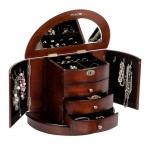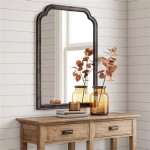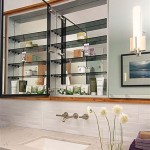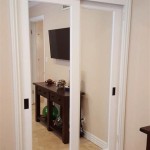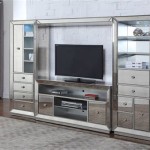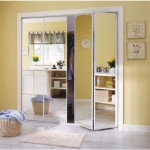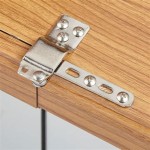Hanging a Heavy Mirror With D-Rings
Hanging a heavy mirror, especially one equipped with D-rings, can be a daunting task. Improper installation can lead to damage to the wall, the mirror itself, or even injury. This article provides a comprehensive guide to safely and securely hanging a heavy mirror with D-rings, ensuring a beautiful and lasting display.
Understanding D-Rings and Their Placement
D-rings are metal hardware attached to the back of a mirror, providing a secure anchor point for hanging. They are typically positioned a certain distance from the top and sides of the mirror. Before attempting to hang the mirror, carefully examine the placement of the D-rings. The distance between the rings and the top edge of the mirror will influence the type of hanging hardware needed. Measure the distance between the D-rings to determine the appropriate spacing for the wall anchors.
The position of the D-rings also influences the stability of the hanging mirror. Ideally, D-rings are positioned so that the mirror hangs flush against the wall. However, some mirrors may have D-rings placed lower, potentially causing the bottom of the mirror to tilt away from the wall. In such cases, shims might be required to ensure a flush fit.
Choosing the Right Hardware and Tools
Selecting the correct hardware is crucial for safely hanging a heavy mirror. The combined weight of the mirror and the hanging hardware dictates the type and strength of wall anchors required. Consult a weight capacity chart available at most hardware stores to determine the appropriate anchor for the weight. Common options include heavy-duty drywall anchors, toggle bolts, or even mounting directly to wall studs whenever possible.
The type of wire or hanging hardware used to connect the D-rings to the wall anchors is equally important. Heavy-duty picture wire or braided steel cable are recommended for heavier mirrors. Avoid using thin wire or cord, as these are less likely to support the weight and may break, resulting in damage or injury.
Gather the necessary tools before beginning the installation process. These typically include a stud finder, level, measuring tape, drill with appropriate drill bits (if required for the chosen wall anchors), a pencil for marking, and a screwdriver.
Preparing the Wall and Marking Anchor Points
Locate the wall studs using a stud finder. Hanging the mirror directly on studs provides the most secure support, especially for heavier mirrors. If mounting on studs isn't feasible, choose appropriate wall anchors for the wall type and the weight of the mirror.
Once the studs are located (or the decision is made to use wall anchors), determine the desired hanging height for the mirror. Using the measurements taken earlier (distance between D-rings and top edge of the mirror), mark the location of the first anchor point on the wall with a pencil. Use a level to ensure this mark is perfectly horizontal. Then, measure the distance between the D-rings and transfer this measurement to the wall, marking the location of the second anchor point. Double-check the horizontal level of both marks and their distance apart.
Installing the Wall Anchors and Hanging the Mirror
Install the chosen wall anchors following the manufacturer's instructions. Ensure the anchors are securely fastened to the wall. For heavier mirrors, using anchors rated for a significantly higher weight than the mirror itself provides an added safety margin.
Attach the chosen hanging wire or cable to the D-rings. Ensure the wire or cable is securely fastened and allows the mirror to hang at the desired height. For heavier mirrors, consider using two lengths of wire or cable, one for each D-ring, rather than a single length strung between them. This provides additional support and prevents the mirror from tilting.
Ensuring Stability and Safety
Once the mirror is hanging, carefully check its stability. Gently push on the top and sides to ensure it is secure and won’t shift or tilt. If the mirror feels unstable, double-check the wall anchors and the wire or cable connection. If the bottom of the mirror tilts away from the wall, small, clear plastic bumpers or shims can be applied to the bottom corners to provide a more flush fit.
Regularly inspect the hanging hardware and the wall anchors for any signs of wear or loosening. Over time, vibrations or accidental bumps can compromise the installation. Addressing any issues promptly prevents damage and ensures the mirror remains securely mounted.
Alternative Hanging Methods for Extra Heavy Mirrors
For extremely heavy or oversized mirrors, consider using a French cleat system. A French cleat consists of two interlocking pieces of wood, one attached to the wall and the other to the back of the mirror. This system distributes the weight evenly across a wider surface area, providing a more secure hold than traditional D-rings and wire. Consult a professional for installation if you are unsure about using a French cleat system or if the mirror is exceptionally heavy.

Picture Wire Strung Between Two D Rings Attached To The Back Of A Frame Hanging Mirror Heavy

Heavy Duty Large Picture Mirror Hanging Kit 50kg Hook D Ring Set

How To Hang A Heavy Mirror With Pictures Wikihow

How To Hang A Heavy Mirror The Home Depot

How To Hang A Mirror With Wire Pictures Wikihow

How To Hang A Heavy Mirror The Home Depot

Heavy Duty Large Picture Mirror Hanging Kit 50kg Hook D Ring Set

How To Hang A Heavy Mirror The Home Depot

How To Hang A Heavy Mirror On Brick Fireplace Drill Into Dans Le Lakehouse

How To Hang A Mirror Perfectly

